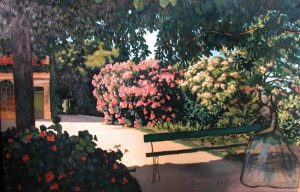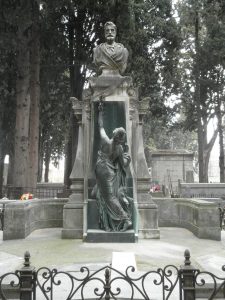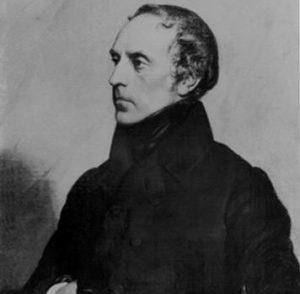A young painter of impressionism
Frédéric Bazille was born in a family that loved and protected the arts. It had many master goldsmiths under the Ancien Régime, and in 1779 two members of the family were among the founders of the Society of Fine Arts in Montpellier. Young Frédéric discovered art at his neighbour’s Alfred Bruyas, a great collector.
In the Autumn of 1862, Bazille obtained the permission of his parents to let him go to Paris and to further his artistic apprenticeship after he passed his doctorate in medicine. He registered for the workshop of the Swiss painter Gleyre, recommended by artist relatives. There he met young painters, namely Renoir, Sisley and Monet who quickly became his best friends and comrades in the fight for the triumph of ‘New painting’. His friend Edmond Maître said ‘Bazille was the most gifted and the most lovable in every sense of the word’.
Claude Monet introduced Bazille to outdoor painting, first in the Fontainebleau forest, in the footsteps of the Barbizon painters, and then in Normandy, Monet’s favorite region. Bazille was more sensitive to the high brightness of his native Languedoc, with its contrasted plans and coloured shadows, than to the wet skies of the Ile-de-France. So that was where he painted most of his outdoor paintings, still in traditional form but flooded with beautiful southern light.
Bazille lived comfortably, thanks to his family, and was inexhaustibly generous with his friends, helping them with loyalty and discretion. In 1866 he submitted two canvasses to the Salon des Indépendants: Young lady at the Piano –refused-, and a still life with fish –accepted. The 1868 Salon featured two canvases: Family reunion and flowerpot, which attracted Zola’s attention.
A short career interrupted by the war
As the war against Prussia broke out, Bazille enlisted in the army on 16 August 1870, against the will of his relatives, with the 3rd Zouave regiment based in Philippeville in Algiers.
Why did he enlist? There are many hypotheses: patriotic fervour or suicidal act? A will to prove his worth to his relatives and to himself? Entertainment? His letters to his family showed his desire to serve his endangered country, as some friends from Montpellier and some of his cousins did too. Bazille may have wished to discover northern Africa where he might meet his uncle, Commandant Lejeune, then a commanding officer on duty at Constantine.
At the end of September in 1870, Bazille’s regiment landed in France and was sent to the eastern front, and then to the Loire valley. On 27 November, Bazille was promoted to Sargent Major and declared during the toast to celebrate his stripe: ‘As for me, I shall not be killed, I have too much to accomplish in life’. The following day he was fatally wounded in the assault of Beaune-la-Rolande (Loiret).
Bazille was not the only painter who died among the 139,000 dead in the 1870-71 war. Victor Giraud (1840-1871), the son of Pierre François Eugène Giraud, a painter who won medals at the 1867 and 1868 salons, died of pneumonia he had contracted during the war. Henri Regnault (1843-1871), prize of Rome 1866 was killed at the battle of Buzenval. A memorial was dedicated to him and to the six other Paris Beaux Arts students who had died in action. The monument was a model for Bazille’s tomb at the Protestant cemetery in Montpellier designed by Auguste Baussan in 1893.
A belatedly rediscovered work
Bazille painted barely more than sixty pictures between 1862 and 1870. He did not sell any while he was alive, and had only five exhibited at the Salons of the Palace of Industry in Paris in 1866, 1868, 1869 and 1870.
His work was rediscovered thanks to donations made by his family. In 1898, Mrs Bazille, the painter’s mother, offered two canvasses, namely View of a village and still life with a heron, to the Musée Fabre in Montpellier, to make sure his son would be posthumously recognised. The View of a Village was displayed two years later at the Universal Exhibition in Paris in 1900 at the Grand Palais as well as La Toilette, lent by Bazille’s family. In 1909 Marc Bazille, his brother, sold the Family reunion to the French State. It is presently exhibited at the Musée d’Orsay in Paris. The first retrospective of Frédéric Bazille’s work exhibited 23 paintings at the Grand Palais in Paris in 1910. The art critic Gaston Poulain developed a passion for Bazille’s work and helped improve his reputation.
Thus did Bazille progressively become part of art history, in the history of early impressionism: in 2016 the great exhibition devoted to him was entitled Fédéric Bazille, the youth of expressionism.
Protestant painting?
Bazille was not interested in Huguenot history, in 1867, for instance, when he painted in Aigues-Mortes, he was mainly interested in the city walls and in the colour of the ponds, but not in the history of the Constance Tower. In 1870 when he painted Ruth and Booz, he was probably more inspired by Victor Hugo’s poem ‘Booz asleep’, published in 1859 in La Légende des sciècles –The Legend of Ages, than by the Bible. Few of his paintings show religious subjects: The Mystic marriage of Saint Catherine, a copy of Veronese’s painting he made in 1859 , was based on a Catholic theme. That is precisely why Bazille’s father, Gaston, donated it to the Church in Beaume-la-Rolande in 1871 to thank abbot Cornet, the vicar of the parish, who helped to find Frédéric’s body.
Some reviewers saw Huguenot and Mediterranean aspects of Impressionism in Bazille, not obeying an immediate sensation, but judging and reasoning it, thus imparting the characters with an unforgettable feeling of time regained…
Paradoxically, Bazille expressed Protestantism in everyday scenes. He painted the everyday life of the Protestant upper middle-class he stemmed from, i.e. the Saint-Sauveur farm where his father developed breeding and growing vineyards; Sunday activities shared by Protestant families like hunting; some summer scenes such as picnics and bathing; portraits; and last but not least the superb Family Reunion (1867-1868), one of his best known works, painted on the terrace of the domaine de Méric in Montpellier, his family’s property, and the symbol of the upper middle-class whose influence was without parallel and out of all proportion to the number of their members.





